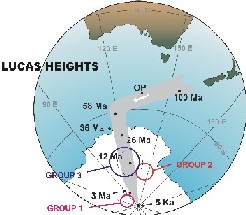2003 News Archive
Dating ferruginous regolith
Dr Brad Pillans, Australian National University - April 2003
Australian regolith is typically strongly oxidised, and characterised
by a variety of ferruginous segregations including nodules, concretions,
cements and colour mottles. Such materials, when dominated by hematite,
are suitable for paleomagnetic dating, as illustrated by Brad Pillans’
role in dating regolith at Lucas Heights last year.
In late July 2002, Brad was asked to assist in geological assessment
of the risk associated with faults that were discovered in the excavations
for the replacement nuclear reactor at the ANSTO Lucas Heights facility
in Sydney. Critical to the assessment was constraining the timing
of last movement on the faults by paleomagnetic dating of an unfaulted
iron oxide layer.
Brad’s initial measurements had demonstrated that the layer
was of reversed polarity, and therefore older than the last major
reversal of the Earth’s magnetic field (the Matuyama-Brunhes
reversal), dated at 780,000 years.
However, a review panel from the International Atomic Energy Agency
(IAEA) concluded that such a minimum age was not “adequately
conservative” because one fault strand had a reverse component
of movement, consistent with the present regional stress field that
has prevailed for the last 20 million years.
Brad then suggested that he might be able to establish an older
minimum age by using the Cainozoic Australian apparent polar wander
path. A month of intensive work followed, during which time Brad
measured many more samples, sufficient to calculate a well-defined
paleomagnetic pole. In the end, three groups of ages were determined
(Figure 1), reflecting the long duration of weathering and iron-oxide
formation at Lucas Heights. The critical group of specimens (Group
2) from the unfaulted iron oxide layer yielded an age estimate of
94 million years, which the review panel accepted as sufficiently
long to establish the fault as “non-capable”. In other
words, the risk of future fault movement was negligible, and approval
was given to proceed with construction at the reactor site.
The paleomagnetic methods used in the Lucas Heights study have
been widely applied by Brad, and PhD student Martin Smith, and are
beginning to provide a chronological framework for ferruginous regolith
throughout Australia. Brad presented a summary of this work at the
Australian Geological Congress in Adelaide last year, showing that
deep oxidation of ferruginous saprolite has been markedly episodic
over the past 200 Ma. Martin and Brad, in conjunction with Jim Dunlap,
are also investigating the application of (U-Th)/He dating methods
to dating iron oxides.
The economic and social benefits that stem from CRC LEME’s
regolith dating project are not always obvious to the wider community.
At a time when more and more government and industry funds are being
directed to applied science, the Lucas Heights study is a timely
reminder that there must also be continued funding for the kind
of basic or pure science that underpins the applications.
 Paleomagnetic
poles, determined by Brad Pillans, for three groups of ferruginous
regolith samples from Lucas Heights (circles are 95% confidence
limits for each pole), compared with the Late Cretaceous-Cainozoic
apparent polar wander path for Australia. Ages of reference poles
are in millions of years (Ma). OP = late Cretaceous thermal overprint
pole from Sydney Basin. Paleomagnetic ages are 2±1 Ma (Group
1), 9± 4 Ma (Group 2 = unfaulted iron oxide layer) and 14±8
Ma (Group 3). Paleomagnetic
poles, determined by Brad Pillans, for three groups of ferruginous
regolith samples from Lucas Heights (circles are 95% confidence
limits for each pole), compared with the Late Cretaceous-Cainozoic
apparent polar wander path for Australia. Ages of reference poles
are in millions of years (Ma). OP = late Cretaceous thermal overprint
pole from Sydney Basin. Paleomagnetic ages are 2±1 Ma (Group
1), 9± 4 Ma (Group 2 = unfaulted iron oxide layer) and 14±8
Ma (Group 3).
(Click on the image to view larger version)
|
